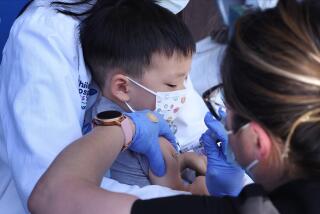L.A. School Hepatitis Vaccination Campaign Reaches Halfway Point
- Share via
Health officials trying to head off a potential hepatitis A outbreak inoculated hundreds more Los Angeles schoolchildren Friday as an emergency campaign reached the halfway point.
Authorities said they hope by Tuesday to have inoculated all of the estimated 9,000 students who ate what may have been contaminated strawberry desserts served in school cafeterias.
“We’ve missed literally a handful of people at some schools, but we’re still within the 14-day window for inoculations,” said Dr. Helen Duplessis, director of student medical services for the Los Angeles Unified School District. The hunt for stragglers “could spill over to next Wednesday or Thursday if necessary,” she said.
Immune globulin shots containing antibodies that help resist the hepatitis A virus were administered to 2,692 pupils Friday at Weemes, Magnolia, Plummer, Strathern, Haddon and Wilton Place elementary schools. Officials said 499 children were inoculated Thursday in the first round of shots.
Monday’s inoculations are scheduled at Alta Loma Elementary School and Bell, Garfield and Fremont high schools.
Although school officials had put out a request for “modesty screens” for high school students receiving the shots, Los Angeles County health officials decided Friday that the older pupils will receive their shots in their arms instead of in their buttocks, spokeswoman Sharon Wanglin said.
Tuesday’s clinics are planned for Trinity Elementary School and Mt. Vernon and Virgil middle schools. “We’ll also do some cleanup work at several other schools” for pupils who missed earlier clinics, Duplessis said.
As local authorities continued with inoculations, health officials elsewhere were widening their search for frozen strawberries possibly tainted with the hepatitis A virus. The suspect fruit may have been distributed to as many as 250 restaurants and stores in southeastern Michigan as well as schools, officials said.
Duplessis and Wanglin said there is no test that will show whether food has been contaminated by the virus--which produces flu-like symptoms but is rarely fatal.
More to Read
Sign up for Essential California
The most important California stories and recommendations in your inbox every morning.
You may occasionally receive promotional content from the Los Angeles Times.











